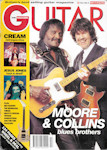
|
Front Cover
Features large colour photo of Gary Moore & Albert Collins.
"MOORE & COLLINS blues brothers"
CREAM retrospective
JESUS JONES 'rock is dead!'
Plus: Big Country, The Senseless, Things, Multi FX Special, Vintage, Danelectros, and win this Palm Bay".
14 Pages including WHEEL & DEAL dealer suppliment.
|
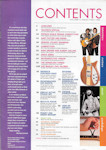
|
Contents page
INTERVIEWS
18 HEROES: STUART ADAMSON
Five faves from the Big Country gentleman
WORKSHOPS
90 ROCK WORKSHOP
After the popularity of last month's Rock Workshop, more from Bill Nelson
Photos: Alber Collins and Gary Moore by Neil Cooper. The Senseless Things by Ed Sirrs/Retna. Cream by LFI, Jesus Jones by Dave Willis/Idols.
|

|
Page 18
HEROES - FIVE FAVOURITE RIFFS THIS MONTH: STUART ADAMSON
Ten years on since they crashed the synthpop and new romantic dominated charts and Big Country are still going strong. They've split with their old record label and are now back on
Chrysalis with a new album, The Buffalo Skinners. Leader Stuart Adamson is certainly happier now; 'It's great to be back in a situation where the company just says, "Here's some
money, go and make an album!"
Stuart describes Big Country's instantly recognisable sound quite simply — 'It's folk music with loud guitars. That's what I get off on; playing the guitar and singing songs
with some strong emotional content.'
It's perhaps no surprise then that he chooses on one the band's anthemic singles, Wonderland, as his favourite song and riff.
'There's a lot of real neat interplay going on inbetween the guitars on that one. Bruce is playing an almost Funky thing against my very strident barre(sic) chords. Bruce just plays what I
can't when I'm trying to sing onstage ha ha! The way the song has developed I've is great too — there's a whole area where we just wait to see what happens, a real spontaneous thing, and I think
that's why we're still playing it and why it's lasted well.'
Led Zeppelin - Heartbreaker
'Every second song has an absolute cracking riff on it, so it's hard to pin down but I think I'd say Heartbreaker. Jimmy Page's playing was so innovative without being flash just for flashness' sake
and he was the one who really made me one to play the guitar. I also loved —Kllling Floor and that led me back to old Blues stuff.'
Roxy Music - Pyjamarama
'Phil Manzanera's solo on this must be the most glorious lick ever recorded! It's 22 years old and I still get shivers, and that's good enough for me. This is just absolutely superb — a great player,
great textures, great melodies'.
Be-Bop Deluxe - Futurama
'I'm going to have to say the whole album 'cause I'm the ultimate Bill Nelson fan. When I met him I even got him to sign the back of my guitar, and he produced the second Skids album too. I must have seen
him play 15 times or so but you can always learn off Bill. He's my favourite guitar player of all time, no doubt. I just wished he hadn't gone up that synthesiser cul-de-sac. '
Nils Lofgren - Back It Up
'I've always really loved Nils' especially on his first three solo albums. The harmonics he gets are great. His voice is so sweet too, and this track has really lasted for me.'
|
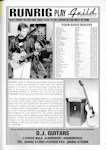
|
Page 85 (Full page advert)
RUNRIG PLAY GUILD
RUNRIG's music is traditional yet modern, loud but gentle and is original and steeped in Celtic roots. The rhythm guitar in an electric folk rock band plays a pivotal role. It
has to be sonorous, driving, loud and totally musical. DONNIE MUNRO of RUNRIG has found the GUILD SONGBIRD is the only guitar that gives him these qualities.
The guild Songbird and Songbird S4CE are a combination of a solid electric guitar and a classic acoustic guitar. The back and rims are carved from one piece of mahogany,
there are no joints. The top is solid spruce and braced like a classical guitar. The Songbird sounds sweet as soon as you pick it up and sonorous unplugged! When you plug
the Songbird in to an amp or P.A. the custom designed active pre-amp gives a totally acoustic guitar sound at any volume. Artists as diverse as Runrig to Aerosmith, Eric Clapton
to the Bee Gees love their Songbirds. Try a Songbird or S4CE at your dealer or send for a brochure to D.J. GUITARS.
D.J. GUITARS
2 STOCKS WALK, ALMONDBURY, HUDDERSFIELD.
TEL. (0484) 512601/425920 FAX. (0484) 515384
|
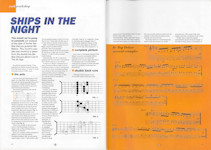
|
Pages 90 & 91
Rock Workshop
SHIPS IN THE NIGHT
This month we're going to conclude our analysis of the style of former Be-Bop DeLuxe guitarist Bill Nelson. This month's solo (like last month's) is taken
from the double live Be-Bop DeLuxe album Live In The Air Age.
As with the previous article, I'll be drawing from further musical examples from this same album, in order to create a broader picture of Bill's style.
· the solo
The solo from the song Ships In The Night, is a neat little 16 bar statement that acts as a good example of how the chords of a straight forward diatonic progression can be used to give your
solo interest and direction.
The chords behind the solo are all from the key of C;
Am (vi) ///, ////, F (IV) ///, ////
Am (vi) ///, ////, G (V) ///, ////
Em (iii) ///, ////, F (IV) ///, ////
G (V) ///, ////, G (V) ///, ////
However, the tonal centre of the progression is the Am (vi), so the scale used is A Aeolian mode (natural minor scale), which (as you should know by now) contains an A minor Pentatonic framework.
(See scale diagram Fig. 1).
Bar 1 starts with a simple A min Pentatonic idea that we saw in bar 2 of last month's solo. Note how Nelson ends the run by bending the D note (4th) of the A min scale up to the F (b6)
to correspond to the root of the F major chord. (See Fig. 2).
This is very similar to the principle used in the first phrase of Jimmy Page's solo on the Led Zep classic Stairway To Heaven.
Bars 5-6 contains another example of Nelson's use of the ascending Pentatonic pattern that we saw being used in bars 1 and 11 last month's solo. The ascending phrase in bars 5-6 at the
start of bar 7 ends with a D (4th note of A min), which is the 5th of the G chord.
Bars 7-8 contains the shape shown in Fig.3, which is another Nelson favourite. This is an arpeggio framework that will fit around the (I) and (V) chords in a major key,
as it's a major triad (ie. 1, 3 and 5) with an added fourth interval.
Harmonically, the 4th is used as a passing note from the 5th to 3rd interval (as it doesn't belong to the chord).
In bars 9-10 Nelson changes from A minor Pentatonic/Blues scale to E min Pent/Blues scale in order to correspond to the E min chord, and plays a phrase very similar to the one found in bar 10
of last month's solo (I'm drawing attention to these similarities so that you can see how it's possible to produce totally different sounding solos simply by stretching and re-working a familiar
vocabulary).
In bars 11-12 Nelson uses another favourite arpeggio idea around the F chord (he uses the same idea, over an E chord, in the track Shine). The only thing to watch out for is the
chromatic passing notes that are used between the arpeggio's 5th interval, C (15th fret of the A string) and its 3rd interval, A (12th fret of the A string). This is a very common approach in
Jazz/Be-Bop.
Finally bars 13-16 contains an arpeggio idea that is now based around the G chord. This is another Jazz/Be-bop device of using chromatic 'lead-in' or 'neighbour' tones to introduce each arpeggio
note. A rhythmically displaced version of this exact idea is used again on the track Life In The Air Age. (see musical Ex. 1)
· complete picture
Any review of the guitar playing of Bill Nelson would be incomplete without looking at another two important aspects of his eclectic style, and that is his abundant use of the Mixolydian
scale and an analysis of those runs that seem to constantly double back on themselves.
· double back runs
Virtually all these types of runs involve Bill using a fractured scale sequence of 4 (ascending). Each run also shares a few other common characteristics. Firstly, their fluid nature comes from
the fact that they're played using left jamd legato, ie, where only the first note of each string is picked and the majority of the notes are played using hammer-ons and pull-offs.
Secondly, there is a characteristically retard at the end of each run as Bill switches from 16th notes to 8th note triplets (and then sometimes to 8th notes).
Finally, there is also the equally characteristic ascent along the length of the high E string using a combination of
|
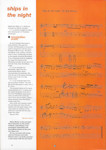
|
Page 92
ships in the night
legato and slides. Ex 2 shoes an excerpt from Mill St Junction.
Ex 3 is another straight run taken from Adventures In A Yorkshire Landscape.
· mixolydian scale
As we've already discussed in many articles in the past few months, the Mixolydian is commonly used in conjunction with the minor Pentatonic/Blues scale. The Minor Pent/Blues scale creates a tension
which is then, traditionally resolved to the happier sounding Mixolydian. This is frequently done by targeting the major 3rd interval of the Mixolydian (usually via the minor 3rd interval of the minor
Pent/Blues scale).
Ex 4 is an example in E Mixolydian, taken from the instrumental Shine, which demonstrates this perfectly. Also note the use of the same chromatic device used in bar 12 of this month's solo.
Ex. 5 is an example taken from the song Piece Of Mine. This time Bill uses B Mixolydian to play over a B7 chord.
This example shares all the same characteristics of Ex. 4, along with the added dimension of the b5 of the minor Pent/Blues scale being used, as well as the customary minor 3rd to set up tension,
before being resolved to the Mixolydian modes major 3rd.
Next month we're going to leave the seventies and move into the eighties with the guitar player most responsible for marking out the distinction between the two eras - Eddie Van Hale.
See you then
Shaun Baxter
Shaun Baxter is the principal Rock instructor at The Guitar Institute, specialising in the techniques associated with Rock/Metal players of the post Van Halen era.
He has recorded with artists such as Princess and John Sloman and is currently pursuing a solo career with his own band.
|











